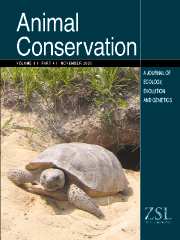Crossref Citations
This article has been cited by the following publications. This list is generated based on data provided by
Crossref.
2004.
Livestock Biodiversity.
p.
217.
KUMAR, SATISH
GUPTA, JALAJ
KUMAR, NIRAJ
DIKSHIT, KIRTI
NAVANI, NAVEEN
JAIN, PRADEEP
and
NAGARAJAN, MUNIYANDI
2006.
Genetic variation and relationships among eight Indian riverine buffalo breeds.
Molecular Ecology,
Vol. 15,
Issue. 3,
p.
593.
LANCASTER, M. L.
GEMMELL, N. J.
NEGRO, S.
GOLDSWORTHY, S.
and
SUNNUCKS, P.
2006.
Ménage à trois on Macquarie Island: hybridization among three species of fur seal (Arctocephalusspp.) following historical population extinction.
Molecular Ecology,
Vol. 15,
Issue. 12,
p.
3681.
Zhang, Y.
Sun, D.
Yu, Y.
and
Zhang, Y.
2007.
Genetic diversity and differentiation of Chinese domestic buffalo based on 30 microsatellite markers.
Animal Genetics,
Vol. 38,
Issue. 6,
p.
569.
Kingston, J. J.
and
Gwilliam, J.
2007.
Hybridization between two sympatrically breeding species of fur seal at Iles Crozet revealed by genetic analysis.
Conservation Genetics,
Vol. 8,
Issue. 5,
Yang, Dongya Y.
Liu, Li
Chen, Xingcan
and
Speller, Camilla F.
2008.
Wild or domesticated: DNA analysis of ancient water buffalo remains from north China.
Journal of Archaeological Science,
Vol. 35,
Issue. 10,
p.
2778.
Nicholas, Frank W.
and
Hammond, Keith
2009.
Adaptation and Fitness in Animal Populations.
p.
237.
Zamudio, Kelly R.
and
Harrison, Richard G.
2010.
Molecular Approaches in Natural Resource Conservation and Management.
p.
169.
Neaves, L E
Zenger, K R
Cooper, D W
and
Eldridge, M D B
2010.
Molecular detection of hybridization between sympatric kangaroo species in south-eastern Australia.
Heredity,
Vol. 104,
Issue. 5,
p.
502.
Zhang, Y.
Vankan, D.
Zhang, Y.
and
Barker, J. S. F.
2011.
Genetic differentiation of water buffalo (Bubalus bubalis) populations in China, Nepal and south‐east Asia: inferences on the region of domestication of the swamp buffalo.
Animal Genetics,
Vol. 42,
Issue. 4,
p.
366.
Bhattarai, Bishnu Prasad
Paudel, Prakash Kumar
and
Kindlmann, Pavel
2012.
Himalayan Biodiversity in the Changing World.
p.
41.
MCMAHON, CLIVE R.
ISAGI, YUJI
KANEKO, SHINGO
BOWMAN, DAVID M. J. S.
BROOK, BARRY W.
and
BRADSHAW, COREY J. A.
2013.
Genetic structure of introduced swamp buffalo subpopulations in tropical Australia.
Austral Ecology,
Vol. 38,
Issue. 1,
p.
46.
Kandel, Ram Chandra
Stuart, J.
Barker, F.
and
Melletti, Mario
2014.
Ecology, Evolution and Behaviour of Wild Cattle.
p.
403.
Choudhury, Anwaruddin
2014.
Ecology, Evolution and Behaviour of Wild Cattle.
p.
255.
Werner, Patricia A.
2014.
Invasion Biology and Ecological Theory.
p.
452.
Zhang, Yi
Lu, Yongfang
Yindee, Marnoch
Li, Kuan‐Yi
Kuo, Hsiao‐Yun
Ju, Yu‐Ten
Ye, Shaohui
Faruque, Md Omar
Li, Qiang
Wang, Yachun
Cuong, Vu Chi
Pham, Lan Doan
Bouahom, Bounthong
Yang, Bingzhuang
Liang, Xianwei
Cai, Zhihua
Vankan, Dianne
Manatchaiworakul, Wallaya
Kowlim, Nonglid
Duangchantrasiri, Somphot
Wajjwalku, Worawidh
Colenbrander, Ben
Zhang, Yuan
Beerli, Peter
Lenstra, Johannes A.
and
Barker, J. Stuart F.
2016.
Strong and stable geographic differentiation of swamp buffalo maternal and paternal lineages indicates domestication in the China/Indochina border region.
Molecular Ecology,
Vol. 25,
Issue. 7,
p.
1530.
Kandel, Ram Chandra
Shrestha, Mitesh
Sadaula, Amir
KC, Medha
Maharjan, Jyoti
Solanki, Ghan Shyam
Chalise, Mukesh Kumar
Asada, Masahito
Kaneko, Osamu
Poudel, Ram Chandra
and
Pandey, Kishor
2019.
First report of malaria parasites in water buffalo in Nepal.
Veterinary Parasitology: Regional Studies and Reports,
Vol. 18,
Issue. ,
p.
100348.
Ahmad, Hafiz Ishfaq
Ahmad, Muhammad Jamil
Jabbir, Farwa
Ahmar, Sunny
Ahmad, Nisar
Elokil, Abdelmotaleb A.
and
Chen, Jinping
2020.
The Domestication Makeup: Evolution, Survival, and Challenges.
Frontiers in Ecology and Evolution,
Vol. 8,
Issue. ,
Thapa, Ram
Neupane, Bijaya
Ranabhat, Saara
Poudel, Megharaj
and
Panthi, Saroj
2020.
Habitat suitability of wild water buffalo (Bubalus arnee) in Babai flood plain of Bardia National Park, Nepal.
Global Ecology and Conservation,
Vol. 23,
Issue. ,
p.
e01172.
Sun, T.
Wang, S.
Hanif, Q.
Chen, N.
Chen, H.
and
Lei, C.
2020.
Genetic diversity of mitochondrial cytochrome b gene in swamp buffalo.
Animal Genetics,
Vol. 51,
Issue. 6,
p.
977.


